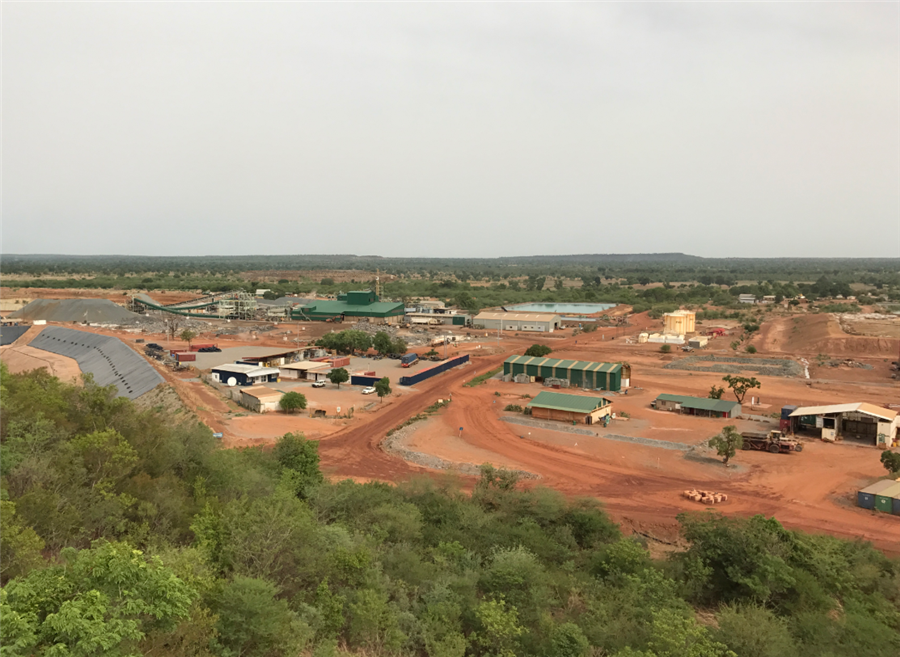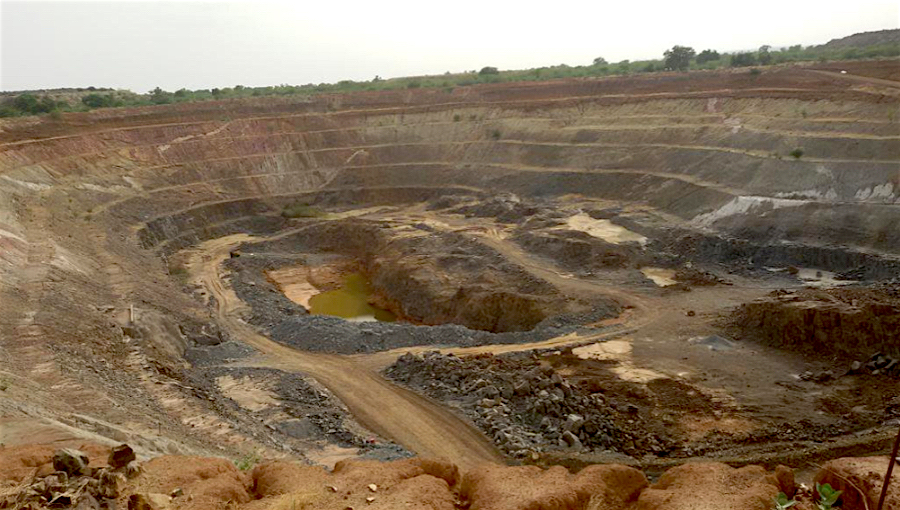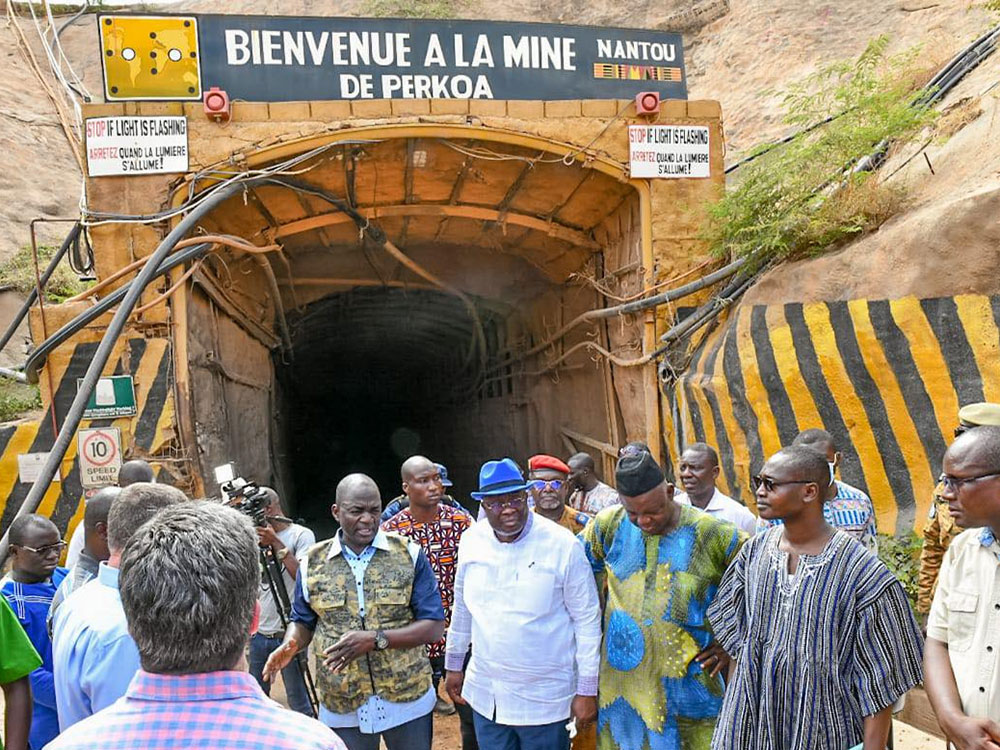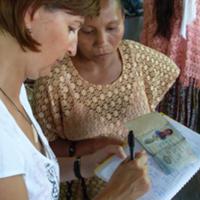BAD CANADIAN MINER IN BURKINA FASO
Trevali’s missing workers failed to reach Perkoa mine’s refuge chamber during floodsStaff Writer | May 18, 2022

Perkoa Zinc Mine – Image courtesy of Trevali Mining Corporation
Trevali Mining (TSX: TV) said the eight missing miners, for whom rescuers have been searching since the company’s Perkoa mine in Burkina Faso was hit by flash floods last month, have failed to reach the mine’s refuge chamber situated more than 500 metres below the surface.

“This is devastating news,” the company’s CEO Ricus Grimbeek said in a press release on May 17. “We would like to offer our deepest sympathies to our colleagues’ families and friends during this difficult time.”
The search for the missing miners will continue, he added.
The Burkina Faso government, in a statement on social media, confirmed that the rescue teams found the refugee chamber empty.
On Apr. 16, heavy rains outside the usual rainy season poured about 125 mm of rain in less than an hour, triggering flash floods that breached the open pit at Perkoa, located about 120 km west of the capital of Ouagadougou.
As the water entered the open pit and underground mine, electricity and communications were lost. While most workers escaped, the company hasn’t been able to communicate with the eight missing workers.
Six out of the eight missing men are from Burkina Faso, while the other two are from Tanzania and Zambia.
The rescue team and the company have been pumping water from the bottom of the mine at level 710 over the last month. The refuge chamber is located below level 520 of the mine.
“Rescue team members reached the refuge chamber… (it) was found intact and with no one inside. It is now clear that none of the eight missing workers reached the refuge chamber,” Trevali said.
The Perkoa mine produced 316.2 million payable lb. of zinc in 2021 and generates the bulk of the company’s revenue. Trevali owns 90% of the mine, while Burkina Faso holds a 10% interest.
According to Scotiabank analyst Orest Wowkodaw, the company’s credit facility matures in the third quarter of 2022. “Securing a refinancing package to replace its maturing credit facility and to fund development of the proposed Rosh Pinah expansion project (in Namibia) has been complicated by the Perkoa incident,” he wrote in a note to clients on May 16.
A McKinsey & Co. report published in 2020 stated that commodities like iron ore and zinc, based on their location, are more exposed than other materials to “extremely high flood occurrence.”
Flooding affects some commodities more than others, based on their location; in McKinsey’s analysis, iron ore and zinc are the most exposed to extremely high flood occurrence, at 50% and 40% of global volume, respectively.

Perkoa Zinc Mine – Image courtesy of Trevali Mining Corporation
Trevali Mining (TSX: TV) said the eight missing miners, for whom rescuers have been searching since the company’s Perkoa mine in Burkina Faso was hit by flash floods last month, have failed to reach the mine’s refuge chamber situated more than 500 metres below the surface.

“This is devastating news,” the company’s CEO Ricus Grimbeek said in a press release on May 17. “We would like to offer our deepest sympathies to our colleagues’ families and friends during this difficult time.”
The search for the missing miners will continue, he added.
The Burkina Faso government, in a statement on social media, confirmed that the rescue teams found the refugee chamber empty.
On Apr. 16, heavy rains outside the usual rainy season poured about 125 mm of rain in less than an hour, triggering flash floods that breached the open pit at Perkoa, located about 120 km west of the capital of Ouagadougou.
As the water entered the open pit and underground mine, electricity and communications were lost. While most workers escaped, the company hasn’t been able to communicate with the eight missing workers.
Six out of the eight missing men are from Burkina Faso, while the other two are from Tanzania and Zambia.
The rescue team and the company have been pumping water from the bottom of the mine at level 710 over the last month. The refuge chamber is located below level 520 of the mine.
“Rescue team members reached the refuge chamber… (it) was found intact and with no one inside. It is now clear that none of the eight missing workers reached the refuge chamber,” Trevali said.
The Perkoa mine produced 316.2 million payable lb. of zinc in 2021 and generates the bulk of the company’s revenue. Trevali owns 90% of the mine, while Burkina Faso holds a 10% interest.
According to Scotiabank analyst Orest Wowkodaw, the company’s credit facility matures in the third quarter of 2022. “Securing a refinancing package to replace its maturing credit facility and to fund development of the proposed Rosh Pinah expansion project (in Namibia) has been complicated by the Perkoa incident,” he wrote in a note to clients on May 16.
A McKinsey & Co. report published in 2020 stated that commodities like iron ore and zinc, based on their location, are more exposed than other materials to “extremely high flood occurrence.”
Flooding affects some commodities more than others, based on their location; in McKinsey’s analysis, iron ore and zinc are the most exposed to extremely high flood occurrence, at 50% and 40% of global volume, respectively.
Burkina Faso rescuers find no survivors in flooded mine’s rescue chamber
Reuters | May 17, 2022

The Perkoa zinc mine is located 120 km away from Burkina Faso’s capital city Ouagadougo. It is the first large-scale base metal mine in that country.

The Perkoa zinc mine is located 120 km away from Burkina Faso’s capital city Ouagadougo. It is the first large-scale base metal mine in that country.
(Image courtesy of French Ambassador to Cameroon Gilles Thibault via Twitter)
Rescue workers have found no survivors in a rescue chamber deep inside a flooded zinc mine in Burkina Faso, the government and the mine owner said on Tuesday, all but extinguishing hope that eight missing miners could still be alive after a month.

The Perkoa mine, owned by Canadian firm Trevali Mining Corp and located about 120km (75 miles) west of the capital Ouagadougou, was abruptly submerged on April 16 after torrential rain fell unexpectedly during the country’s dry season.
There had been faint hope during a month-long search and rescue operation that the missing men might have reached the rescue chamber, which is stocked with food and water and located around 570 metres below ground.
“The rescue teams have opened the refuge chamber, unfortunately it is empty,” the government’s information service said in a statement posted on social media.
Trevali said the refuge chamber had been found intact, and it was now clear none of the eight missing workers had reached it.
“This is devastating news, and we would like to offer our deepest sympathies to our colleagues’ families and friends during this difficult time,” said Ricus Grimbeek, President and CEO of Trevali, in a statement.
“We will continue our search efforts unabated and reaffirm our commitment to work at full-speed to find our colleagues.”
Distraught relatives of the missing men have been gathering every day at the site in the Sanguie province, seeking solace from each other as they faced the agonising wait for news.
Deadly mining accidents are common in Africa. The Perkoa flood garnered more attention than many because of the hope, albeit remote, of an outcome similar to the dramatic 2010 rescue in Chile of 33 miners who had spent 69 days underground — but it was not to be.
Complex operation
Both the company and the government have launched investigations into the causes of the disaster. The prime minister said on May 2 that mine managers had been banned from leaving the country.
The Perkoa mine consists of an open pit with underground shafts and galleries below. Most of the workers who were there at the time of the flash flood were able to escape, but the missing eight were more than 520 metres (1,706 feet) beneath the surface.
Six of the missing men are Burkina Faso nationals, one is from Tanzania and one from Zambia.
With many in Burkina Faso asking why it took so long to reach the rescue chamber and criticism of the company and state emergency services mounting, Trevali said the technical challenges were immense.
The violence of the flood was such that it washed away the road leading down into the mine as well as damaging electricity supply. The road had to be resurfaced and power restored before a full-scale search could begin.
Initially, equipment was being carried down on foot, but vehicles were necessary to install machinery capable of pumping water from depths below 500 metres.
Rescuers have pumped out about 55 million litres of floodwater, out of an estimated total of 165 million litres that swept through the underground portion of the mine.
(By Anne Mimault, Thiam Ndiaga, Sofia Christensen and Estelle Shirbon; Editing by James Macharia Chege and Ed Osmond)
Rescue workers have found no survivors in a rescue chamber deep inside a flooded zinc mine in Burkina Faso, the government and the mine owner said on Tuesday, all but extinguishing hope that eight missing miners could still be alive after a month.

The Perkoa mine, owned by Canadian firm Trevali Mining Corp and located about 120km (75 miles) west of the capital Ouagadougou, was abruptly submerged on April 16 after torrential rain fell unexpectedly during the country’s dry season.
There had been faint hope during a month-long search and rescue operation that the missing men might have reached the rescue chamber, which is stocked with food and water and located around 570 metres below ground.
“The rescue teams have opened the refuge chamber, unfortunately it is empty,” the government’s information service said in a statement posted on social media.
Trevali said the refuge chamber had been found intact, and it was now clear none of the eight missing workers had reached it.
“This is devastating news, and we would like to offer our deepest sympathies to our colleagues’ families and friends during this difficult time,” said Ricus Grimbeek, President and CEO of Trevali, in a statement.
“We will continue our search efforts unabated and reaffirm our commitment to work at full-speed to find our colleagues.”
Distraught relatives of the missing men have been gathering every day at the site in the Sanguie province, seeking solace from each other as they faced the agonising wait for news.
Deadly mining accidents are common in Africa. The Perkoa flood garnered more attention than many because of the hope, albeit remote, of an outcome similar to the dramatic 2010 rescue in Chile of 33 miners who had spent 69 days underground — but it was not to be.
Complex operation
Both the company and the government have launched investigations into the causes of the disaster. The prime minister said on May 2 that mine managers had been banned from leaving the country.
The Perkoa mine consists of an open pit with underground shafts and galleries below. Most of the workers who were there at the time of the flash flood were able to escape, but the missing eight were more than 520 metres (1,706 feet) beneath the surface.
Six of the missing men are Burkina Faso nationals, one is from Tanzania and one from Zambia.
With many in Burkina Faso asking why it took so long to reach the rescue chamber and criticism of the company and state emergency services mounting, Trevali said the technical challenges were immense.
The violence of the flood was such that it washed away the road leading down into the mine as well as damaging electricity supply. The road had to be resurfaced and power restored before a full-scale search could begin.
Initially, equipment was being carried down on foot, but vehicles were necessary to install machinery capable of pumping water from depths below 500 metres.
Rescuers have pumped out about 55 million litres of floodwater, out of an estimated total of 165 million litres that swept through the underground portion of the mine.
(By Anne Mimault, Thiam Ndiaga, Sofia Christensen and Estelle Shirbon; Editing by James Macharia Chege and Ed Osmond)
African Mine Disaster Turns Spotlight on Canadian Mining Firms
Eight miners are trapped in a mine owned by a Vancouver-based company. Advocates want more accountability.
Amanda Follett Hosgood

Eight miners are trapped in a mine owned by a Vancouver-based company. Advocates want more accountability.
Amanda Follett Hosgood
10 May 2022
TheTyee.ca


Burkina Faso Prime Minister Albert Ouédraogo (centre, in blue hat) visits Perkoa Mine on May 1. Eight miners have been trapped more than 500 metres underground for more than three weeks and hope for a successful rescue is fading. Photo via Burkina Faso government Twitter.
As the search continues for eight African miners trapped underground in a Canadian-owned mine in Burkina Faso, advocates say Canada’s laws should be toughened to ensure greater corporate responsibility.
Vancouver-based Trevali Mining Corp. said Monday that there has been no communication with the miners since heavy rains caused flash flooding at the mine on April 16.
As workers evacuated, eight miners working more than 500 metres underground became trapped, the company said. There has been no contact with the workers, six of whom are local with the remaining two from Zambia and Tanzania, according to news reports.
While extreme weather is blamed for the disaster, Burkina Faso government officials have also placed responsibility on managers at Perkoa Mine, saying the government has launched a judicial investigation. Six of the miners’ families have also taken legal action. The West African country has a population of 20 million.
Catherine Coumans, a research co-ordinator with advocacy group MiningWatch Canada, said environmental and human-rights violations by Canadian mining companies operating overseas are more common than most Canadians realize.
She hopes recently tabled federal legislation could bring about change.
“We are constantly being made aware of these incidents, where workers are put at risk because of working for Canadian mining companies,” Coumans said, pointing to two unrelated recent disasters in Burkina Faso and Ghana. Both mines were owned by Toronto-based companies.
“It’s a matter of cutting corners. It’s a matter of getting away with what you can get away with,” said Coumans. “There is a real problem with lack of accountability and effective impunity when our Canadian companies operate overseas.”
Trevali did not immediately respond to The Tyee’s interview requests or emailed questions.
But in recent updates posted to its website, the company said flooding had eroded the mine’s main access route, which spirals more than half a kilometre underground.
“The torrent of water entering the mine resulted in significant road surface erosion,” the company said, adding that additional pumps could not be moved into the depths of the mine until access was repaired. By April 23, a week after the flood, communications and power had been re-established to 520 metres below ground, it said.
However, the workers remain deeper than that.
“There has been no communication with these workers since soon after the evacuation order was given,” the company said, adding that two refuge chambers located below 520 metres are “designed to provide a refuge for workers trapped in a hazardous environment.”
It added that it did not know if the workers were able to access the chambers.
Even if they had, their ability to survive is likely running out. According to local media reports, shelters within the zinc mine can provide two weeks of water and oxygen, but food remains a problem. The workers have been trapped for over three weeks.
The refuge where the workers may be located is 580 metres below the surface. Local media reported over the weekend that “significant advances” in pumping had cleared flood waters to 550 metres.
On Friday, the government of Burkina Faso called for international help to find the missing miners. “All human and material resources must be deployed on the Perkoa site to give the miners the chance to live,” government spokesman Lionel Bilgo said.
Vancouver-based Trevali, which focuses its operations on zinc production, purchased Perkoa Mine in August 2017. In addition to its Burkina Faso mine, it operates mines in Namibia and northern New Brunswick. It also has non-operational properties in New Brunswick and Manitoba.
Last week, the company cancelled a conference call where it had intended to deliver 2022 first-quarter financial results, saying its primary focus is on the missing miners. The call is now planned for May 16.
In February, Trevali reported that its revenues increased by 61 per cent last year over the previous year, to almost US$350 million. It credited an increase in zinc prices and a reduction in processing costs.
While the company said it had reduced its “significant incidents” by 30 per cent last year, its total recordable injury frequency — the number of incidents requiring medical treatment — were nearly twice those of the previous year.
The underground portion of the Perkoa Mine has been operating since 2013. A 70-metre deep open pit was previously established to access material near the surface, according to a technical report prepared for Trevoli as it took ownership in 2017.
The mine’s portal is located at the base of the open-pit portion of the mine, something flagged as a potential flood risk in the report.
“Great care has been taken to manage rainfall in the portal box cut as this is the biggest exposure to flood,” the report noted, adding that sumps are built into the box cut, or mine entrance, to capture water and reduce its ability to enter the mine.
According to the report, a ventilation shaft “connects all levels” of the mine and also acts as an emergency escape route. At the time of the report, mining was occurring down to 400 metres, with mining at deeper levels slated for possible future development. It noted that more drilling would be needed to determine whether mineral resources were available below 520 metres.
It’s unclear what, if any, exit routes had been established in the more recently developed sections of the mine.
Burkina Faso Prime Minister Albert Ouédraogo has blamed “irresponsibility” on the part of mine managers for the disaster. He said flooding was a result of weakening of the underground gallery due to the use of open-air dynamite.
Mine managers have been barred from leaving the country while the investigation is ongoing.
The families of six trapped miners have reportedly also filed lawsuits against “persons unknown” for attempted manslaughter, endangering life and failing to assist a person in danger.
While Coumans said it’s “rare” to detain company executives following a mining disaster, she isn’t optimistic it will lead to better outcomes or accountability on behalf of the company if wrongdoing is found.
“I would be very surprised if there were actual repercussions for the company or its senior executives,” said Coumans, who noted that in the more than 20 years that MiningWatch Canada has been operating there has been very little progress in holding Canadian companies operating overseas to account.
“The problem of effective impunity when our Canadian companies operate overseas is alive and well,” she said. “It’s no different now than it was in 1999 when we started.”
What has changed, she said, is what she describes as the opening of a “clear path forward” for holding Canadian companies accountable.

Canadian Mining Companies Profit as Guatemalans Suffer, Authors Argue
As the search continues for eight African miners trapped underground in a Canadian-owned mine in Burkina Faso, advocates say Canada’s laws should be toughened to ensure greater corporate responsibility.
Vancouver-based Trevali Mining Corp. said Monday that there has been no communication with the miners since heavy rains caused flash flooding at the mine on April 16.
As workers evacuated, eight miners working more than 500 metres underground became trapped, the company said. There has been no contact with the workers, six of whom are local with the remaining two from Zambia and Tanzania, according to news reports.
While extreme weather is blamed for the disaster, Burkina Faso government officials have also placed responsibility on managers at Perkoa Mine, saying the government has launched a judicial investigation. Six of the miners’ families have also taken legal action. The West African country has a population of 20 million.
Catherine Coumans, a research co-ordinator with advocacy group MiningWatch Canada, said environmental and human-rights violations by Canadian mining companies operating overseas are more common than most Canadians realize.
She hopes recently tabled federal legislation could bring about change.
“We are constantly being made aware of these incidents, where workers are put at risk because of working for Canadian mining companies,” Coumans said, pointing to two unrelated recent disasters in Burkina Faso and Ghana. Both mines were owned by Toronto-based companies.
“It’s a matter of cutting corners. It’s a matter of getting away with what you can get away with,” said Coumans. “There is a real problem with lack of accountability and effective impunity when our Canadian companies operate overseas.”
Trevali did not immediately respond to The Tyee’s interview requests or emailed questions.
But in recent updates posted to its website, the company said flooding had eroded the mine’s main access route, which spirals more than half a kilometre underground.
“The torrent of water entering the mine resulted in significant road surface erosion,” the company said, adding that additional pumps could not be moved into the depths of the mine until access was repaired. By April 23, a week after the flood, communications and power had been re-established to 520 metres below ground, it said.
However, the workers remain deeper than that.
“There has been no communication with these workers since soon after the evacuation order was given,” the company said, adding that two refuge chambers located below 520 metres are “designed to provide a refuge for workers trapped in a hazardous environment.”
It added that it did not know if the workers were able to access the chambers.
Even if they had, their ability to survive is likely running out. According to local media reports, shelters within the zinc mine can provide two weeks of water and oxygen, but food remains a problem. The workers have been trapped for over three weeks.
The refuge where the workers may be located is 580 metres below the surface. Local media reported over the weekend that “significant advances” in pumping had cleared flood waters to 550 metres.
On Friday, the government of Burkina Faso called for international help to find the missing miners. “All human and material resources must be deployed on the Perkoa site to give the miners the chance to live,” government spokesman Lionel Bilgo said.
Vancouver-based Trevali, which focuses its operations on zinc production, purchased Perkoa Mine in August 2017. In addition to its Burkina Faso mine, it operates mines in Namibia and northern New Brunswick. It also has non-operational properties in New Brunswick and Manitoba.
Last week, the company cancelled a conference call where it had intended to deliver 2022 first-quarter financial results, saying its primary focus is on the missing miners. The call is now planned for May 16.
In February, Trevali reported that its revenues increased by 61 per cent last year over the previous year, to almost US$350 million. It credited an increase in zinc prices and a reduction in processing costs.
While the company said it had reduced its “significant incidents” by 30 per cent last year, its total recordable injury frequency — the number of incidents requiring medical treatment — were nearly twice those of the previous year.
The underground portion of the Perkoa Mine has been operating since 2013. A 70-metre deep open pit was previously established to access material near the surface, according to a technical report prepared for Trevoli as it took ownership in 2017.
The mine’s portal is located at the base of the open-pit portion of the mine, something flagged as a potential flood risk in the report.
“Great care has been taken to manage rainfall in the portal box cut as this is the biggest exposure to flood,” the report noted, adding that sumps are built into the box cut, or mine entrance, to capture water and reduce its ability to enter the mine.
According to the report, a ventilation shaft “connects all levels” of the mine and also acts as an emergency escape route. At the time of the report, mining was occurring down to 400 metres, with mining at deeper levels slated for possible future development. It noted that more drilling would be needed to determine whether mineral resources were available below 520 metres.
It’s unclear what, if any, exit routes had been established in the more recently developed sections of the mine.
Burkina Faso Prime Minister Albert Ouédraogo has blamed “irresponsibility” on the part of mine managers for the disaster. He said flooding was a result of weakening of the underground gallery due to the use of open-air dynamite.
Mine managers have been barred from leaving the country while the investigation is ongoing.
The families of six trapped miners have reportedly also filed lawsuits against “persons unknown” for attempted manslaughter, endangering life and failing to assist a person in danger.
While Coumans said it’s “rare” to detain company executives following a mining disaster, she isn’t optimistic it will lead to better outcomes or accountability on behalf of the company if wrongdoing is found.
“I would be very surprised if there were actual repercussions for the company or its senior executives,” said Coumans, who noted that in the more than 20 years that MiningWatch Canada has been operating there has been very little progress in holding Canadian companies operating overseas to account.
“The problem of effective impunity when our Canadian companies operate overseas is alive and well,” she said. “It’s no different now than it was in 1999 when we started.”
What has changed, she said, is what she describes as the opening of a “clear path forward” for holding Canadian companies accountable.

Canadian Mining Companies Profit as Guatemalans Suffer, Authors Argue
READ MORE
In March, the federal NDP tabled two private members bills aimed at improving accountability of Canadian companies abroad by requiring them to do risk assessments on potential harms and demonstrate how they would prevent them. The approach is based on models developed in Europe that ensure corporations and their subsidiaries are not violating human rights or contaminating environments.
“This is what we need. We need mandatory human rights and environmental due diligence in Canada,” Coumans said. “Unless there’s consequences for the harm that’s done… [by] cutting corners they can save money.”
Trevali said in statements posted to its website that it is working around the clock to locate the missing miners and remains in regular contact with their families. The company did not respond to specific questions about what support the families are receiving or The Tyee’s request for an update on the search for the miners.
In March, the federal NDP tabled two private members bills aimed at improving accountability of Canadian companies abroad by requiring them to do risk assessments on potential harms and demonstrate how they would prevent them. The approach is based on models developed in Europe that ensure corporations and their subsidiaries are not violating human rights or contaminating environments.
“This is what we need. We need mandatory human rights and environmental due diligence in Canada,” Coumans said. “Unless there’s consequences for the harm that’s done… [by] cutting corners they can save money.”
Trevali said in statements posted to its website that it is working around the clock to locate the missing miners and remains in regular contact with their families. The company did not respond to specific questions about what support the families are receiving or The Tyee’s request for an update on the search for the miners.


Amanda Follett Hosgood is The Tyee’s northern B.C. reporter. She lives in Wet’suwet’en territory. Find her on Twitter @amandajfollett.
MAY 11, 2022
MAY 10, 2022
MAY 5,2022
APRIL 20, 2022

No comments:
Post a Comment